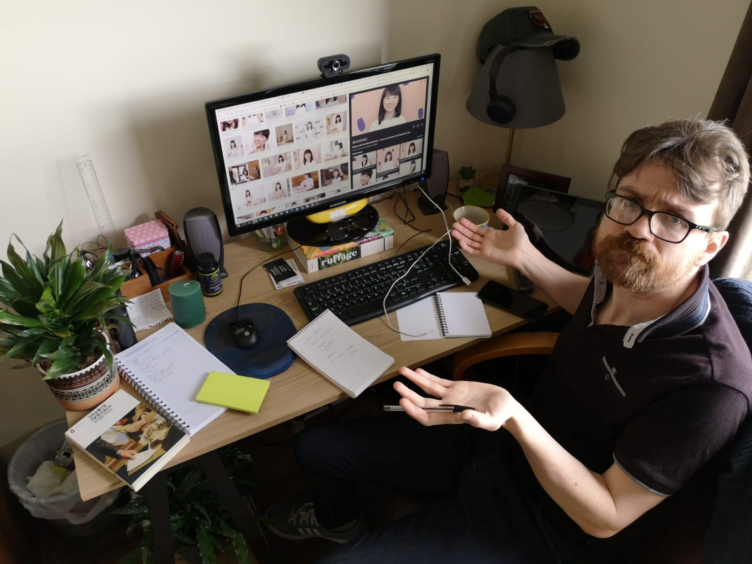
Have you found yourself running the gauntlet of laptop power cords and phone chargers snaking beneath your feet on the way to the kitchen?
Are you being distracted from EastEnders by a pile of unfinished paperwork on the coffee table, sorry, workstation? Is your co-worker in need of a motivational pep talk, a baffled-looking family cat?
Fear not, Marie Kondo is here to help.
The tidying guru is releasing her new book, which aims to help people declutter their workspaces – whether it’s an office or a front room.
Not only that but Marie, whose Netflix series Tidying Up With Marie Kondo became a global hit last year, says her advice can help you enjoy work – and even further your career.
She says: “Quite a few people don’t believe they can find joy in their job. ‘I’m stuck in useless meetings all day long. Tidying’s never going to change that,’ they insist. ‘Besides, too many things are out of my hands. There’s no way work can be joyful.’ In fact, however, it’s tidying up properly that makes it possible to spark joy at work.
“For example, clients have told us the KonMari Method has boosted their sales performance by as much as 20%, increased efficiency to the point where they were able to leave work two hours earlier, and helped them to reassess the meaning of their job, rekindling their passion for it.”
The Japanese guru is known for going into homes and instructing owners how to
create orderly spaces, usually by emptying the rooms and filling the bins.
And, when it comes to Working From Home, it was her experiences in offices that led her to the KonMari Method.
“Most people see me as a specialist in tidying homes, not as someone with expertise in tidying workspaces, let alone in career development,” said 35-year-old Marie.
“While working for a Japanese company, however, I spent most of my spare time teaching company executives how to tidy their offices. It was because I became so busy with these lessons that I finally decided to quit my job and launch my career as an independent consultant.
“The KonMari Method arose from my experiences of teaching people how to tidy up. My approach has two distinct features: it’s simple but effective, ensuring you’ll never revert to clutter, and it uses a unique selection criterion – choosing what sparks joy.
“When we ask ourselves, ‘Does this spark joy?’ we reconnect with our inner self and discover what’s really important to us.”
Marie says there are three ways your things can spark joy but if they don’t? In the bin.
“The first category is things that directly allow us to feel joy. The second is functional joy, things that you use frequently that make your daily work easier. And the third is future joy, things that will contribute to your future plan for your career. For example, invoices themselves may not spark joy for you, but it is what allows you to get payment in the future, so in that sense it sparks joy.
“If a particular item can be categorized into any of those three, I’d choose to keep them.”
How to spark joy: The Marie Kondo method
Where to start
Cleaning up has to be done in order. For tidying the workspace, begin by tidying your books, then papers, followed by komono – any miscellaneous objects – and, lastly, sentimental items. Pile each item on each spot and decide which ones to keep.
Untidy papers
The rule of thumb for papers is to discard everything. My clients always look dumbfounded when I say this. Of course, I don’t mean eliminate papers entirely. Sort them by category and file them in a filing cabinet or in file folders on a shelf. If you don’t need to keep the originals, you can scan them and store them electronically.
Designer fun
Don’t think of it as “tidying”. Tell yourself that you’re designing a joyful place to work, more like decorating. Choosing, for example, pens that spark joy for you. And not just pens. Penholders, scissors or sticky tape – make sure they are ones that you love.
Digital tidy
Don’t just tidy your physical space. Get a handle on your digital space. Keep your phone and laptop tidy. Do it category by category, starting with documents, followed by emails, and finally smartphone apps.
Getting personal
Ask if your personal item sparks joy if you keep it at your desk. If your response is that it once supported you in your work but you no longer need it, thank it for what it gave you, and let it go with gratitude. For those who find tidying up sentimental items difficult, try taking a photo before letting them go.
And finally…
Ask yourself: Do I need this document to get my job done? Will this document provide guidance or inspiration for future work? Does this document spark joy? If the answer is no to all these, delete it. However, be sure to follow any document policy at your organisation.
‘My desk, as I’m sure Marie would put it, is a pure midden’
Is it possible to spark joy in a pandemic?
Like much of the rest of the population who have been forced to convert their homes into offices, I’ve been experiencing a sort of slow-motion mental breakdown, so was happy to spark a little joy the Marie Kondo way.
The good thing about operating from an office is abandoning work at the end of the day and leaving it for some other mug – namely my future self – to pick up in the morning.
That short-sighted, devil-may-care attitude is a lot more difficult to maintain when your desk lurks at the foot of the bed.
Notepad hillocks roll across its surface. Screens and cables battle for space and my attention. Bottles of supplements are dotted around, lest I forget to take the precious Vitamin D keeping my bones from crumbling into raw calcium. My workspace, as Marie might say, is a pure midden. Luckily, though, I received a copy of her new book Joy At Work. It contains tips for those working from home which, as far as I can tell, is almost everyone these days.
First I thought about what items would be useful or spark joy – as per the KonMari Method.
Post-it notes? To whom will I leave a Post-it note? (The cat, to let it know I’ve changed the litter, PS stop eating the ficus plant?) In the bin they went.
Did my notepad, containing months’ worth of hard-won interviews, spark any sort of happiness? Not really. In the (recycling) bin it went.
I began to get into the KonMari rhythm. That spare pair of glasses? Well I only have two eyes, Marie. Bin!
This tidying method stretches to what sort of decisions you make in work, too – deciding to pare back on what decisions you make can even help further your career, apparently.
Perhaps it was the recklessness of owning only one pair of glasses, but when my boss asked me on webcam if I’d like to do any work last week I simply shrugged, safe in the knowledge my joyful, spartan approach would have me running the show in no time.
So try the KonMari Method in your home office if you want to spark joy – and perhaps a Zoom meeting with Human Resources.
Joy at Work: Organising Your Professional Life by Marie Kondo and Scott Sonenshein
is out now.

Enjoy the convenience of having The Sunday Post delivered as a digital ePaper straight to your smartphone, tablet or computer.
Subscribe for only £5.49 a month and enjoy all the benefits of the printed paper as a digital replica.
Subscribe © Seth Wenig/AP/Shutterstock
© Seth Wenig/AP/Shutterstock
